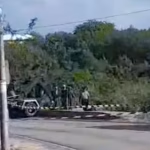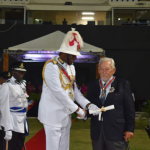By Sir Ronald Sanders
There has been a surge in gang violence and gun violence in Latin America and the Caribbean, leading to a high level of murders and heightened fear in many countries.
The figures are alarming not only for the countries of the Caribbean Community (CARICOM) but also for all other countries in the Americas, including the United States of America and Canada.
The situation has become so alarming that I was prompted, in my capacity as President of the Permanent Council of the Organization of American States (OAS), to hold a Special Meeting on this matter on November 1, 2023. Representatives of 22 countries spoke, painting a worrying picture from both humanitarian and security standpoints.
The consensus from the meeting was undeniable: this is a challenge too vast for any single country to tackle in isolation. However, El Salvador claims that its aggressive measures, including jailing 71,000 gang members (about 2% of its population) have brought a great sense of security to a society that had been terrorized by gang violence for decades. Human rights bodies have criticised the administration of President Nayib Bukele, claiming that some of its stringent measure violate human rights law.
The experience in El Salvador is indicative of the tension between strong law enforcement measures to curb the criminal activity of armed gangs and international humanitarian law which demands that, at all times, individuals be guaranteed the enjoyment of fundamental rights and liberties.
How humanitarian law, in respect of uprooting criminal gangs, meshes with the call for a military force to remove over 60 gangs that are tormenting the country, is one of the paradoxes from which some governments have shied away.
In any event, the panel of experts, who vividly described the scale of the problem of guns, gangs and violence, left no doubt about three things: gangs and guns are in the hands of organised criminal enterprises which operate across borders; the infiltration of guns, mostly from the United States of America (US) is fuelling homicides including assassinations; and national law enforcement agencies lack the capacity to cope with the problem by themselves.
Such conditions partly explain the expansion of gang and criminal activity throughout the Americas. But it is not the full explanation; other factors contribute. Among these are disillusioned, disenchanted and desperate young people who are lured into gangs as a way of getting money and asserting themselves.
The presentation by Trinidad and Tobago’s Attorney-General and Minister of Legal Affairs, Reginald Armour, to the OAS meeting was as startling as it was revealing. For example, he pointed out that “in Jamaica, approximately 70% of the violence is related to criminal organizations, despite the Government’s drastic measures to combat gangs, by the implementation of ‘Gang Suppression’ laws and States of Emergency, repeated military and police operations and the arrest of 149 gang leaders”. He observed that “these gangs continue to evolve with new leaders and a ready supply of illicit firearms originating from the United States”.
Mr. Armour also disclosed that “in Trinidad and Tobago, the combination of firearms and the fragmentation of competing gangs has increased the murder rate, with 614 homicides recorded in 2022”.
This situation in not unique to Jamaica and Trinidad and Tobago, the two most populous states of CARICOM, apart from Haiti. In 2022, official figures showed that 5 CARICOM countries were among the top 10 nations in the world with the highest national murder rates per 100,00 people. The 5 countries were: Jamaica, St Lucia, Belize, Dominica and Guyana in that order. Of the other 5 countries, 4 were Latin American: Honduras, Mexico, Colombia and Brazil.
At the OAS meeting, Romain Le Cour Grandmaison, a senior expert at the Global Initiative against Transnational Organized Crime, pointed out that, “the proportion of firearms involved in national homicides increased from 15% in 1997 to 70% in 2021”. He said that now, around 50 people are murdered with firearms every day. A similar point about the relation between firearms and violence, particularly murder was made by other speakers, including Maria Eugenia Mata of the Ministry of Public Security of Costa Rica.
According to an article from The Economist, “in previously safe countries, murder rates are hitting record levels, including Ecuador, Costa Rica, and Chile. The article calls it the new narco-network: a cocktail of drugs, guns, and migration is fuelling gang violence across the region”.
The Caribbean and Latin America, therefore, lying next to each geographically with many of them bordering the Caribbean sea, have a common problem and a collective responsibility to their peoples to work together to address it effectively.
Undoubtedly, national efforts are underway, yet law enforcement agencies grapple with being underfunded and understaffed. Many are also in need of training and equipment. The OAS Secretariat has done a great body of work that assesses strengths and weaknesses within these security forces, and it has expertise that should be utilized to improve national capacity.
In the face of such stark realities – where firearms, gangs, and transnational crime erode the fabric of our societies – the call for action has never been more pressing. We stand at a crossroads where the only path forward is one of unity, collaboration, and unwavering resolve. It is not just about enhancing law enforcement capabilities; it is about forging an unbreakable chain of solidarity across the Americas.
The OAS is well-placed to spearhead this initiative, transforming policy recommendations into concrete measures: from tightening firearm export controls in the United States to fostering regional intelligence-sharing protocols, from expanding support for community programs that address the root causes of gang recruitment to bolstering judicial systems that can withstand the corruption and influence of organized crime.
OAS member states should commit to a mobilizing the necessary political will and financial resources to implement such a plan. The time for concerted action is now; the cost of delay is simply too great.
(The writer is Antigua and Barbuda’s Ambassador to the US and the OAS. He is also the current President of the OAS Permanent Council. The views expressed are entirely his own. For comments and previous commentaries, see: www.sirronaldsanders.com)










